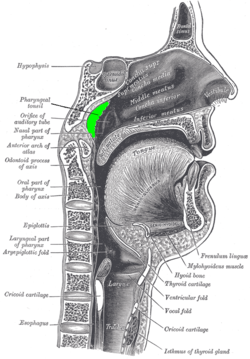Adenoid
This article needs additional citations for verification. (November 2007) |
| Adenoids | |
|---|---|
 Location of the adenoid | |
| Details | |
| System | Lymphatic system |
| Identifiers | |
| Latin | tonsilla pharyngea |
| MeSH | D000234 |
| TA98 | A05.3.01.006 |
| TA2 | 5186 |
| FMA | 54970 |
| Anatomical terminology | |
In
The term adenoid is also used to represent adenoid hypertrophy, the abnormal growth of the pharyngeal tonsils.[1]
Structure
The adenoid is a mass of
Development
Adenoids develop from a subepithelial infiltration of
Function
Part of the immune system, adenoids trap and recognize pathogens such as bacteria and viruses. In response, the adenoid produces
Microbiome
Species of bacteria such as
Clinical significance
Enlargement

An enlarged adenoid, or
Symptomatic enlargement between 18 and 24 months of age is not uncommon, meaning that snoring, nasal airway obstruction and obstructed breathing may occur during sleep. However, this may be reasonably expected to decline when children reach school age, and progressive shrinkage may be expected thereafter.[citation needed]
Adenoid facies
Enlargement of the adenoid, especially in children, causes an atypical appearance of the face, often referred to as adenoid facies.
Removal
Surgical removal of the adenoid is a procedure called adenoidectomy. Adenoid infection may cause symptoms such as excessive mucus production, which can be treated by its removal. Studies have shown that adenoid regrowth occurs in as many as 19% of the cases after removal.[6] Carried out through the mouth under a general anaesthetic (or less commonly a topical), adenoidectomy involves the adenoid being curetted, cauterized, lasered, or otherwise ablated. The adenoid is often removed along with the palatine tonsils.[7]
See also
References
- ^ "Definition of ADENOID". www.merriam-webster.com. Retrieved 2018-05-05.
- ^ Histology at KUMC lymphoid-lymph06
- PMID 30844164. Retrieved 2 June 2023.
- PMID 20129889.
- ^ Wahba, Mohammed. "Adenoid facies". Radiopaedia.org. Radiology Reference Article. Retrieved 2016-11-06.
- S2CID 31941117.
- ^ "Adenoids". MedlinePlus, US National Library of Medicine. 13 September 2022. Retrieved 23 July 2023.
External links
- "Anatomy diagram: 25420.000-1". Roche Lexicon - illustrated navigator. Elsevier. Archived from the original on 2015-02-26.
- Adenoids: What They Are, How To Recognize Them, What To Do For Them
- Histology at usuhs.mil
- Histology at udel.edu
- /drtbalu otolaryngology online
